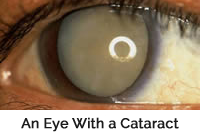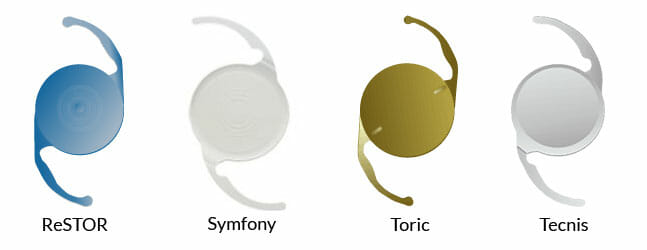
Sierra Nevada Eye Center offers the latest techniques, including no-stitch, no-needle, no-patch outpatient cataract surgery to maximize visual potential to our patients throughout the Reno areas. And Dr. Wolff is the first physician in Nevada to offer TriMoxi for cataract surgery, allowing most patients to avoid using expensive eye drops for cataract surgery.
We are also pleased to offer patients the latest technology…ORA wavefront technology and LenSx femtosecond laser for enhanced accuracy. Drs. Wolff and Westafer have extensive experience with a wide variety of premium intraocular lenses, including multifocal lenses (PanOptix, Tecnis, and ReStor), extended depth of focus, or EDOF lenses (Vivity and Symfony) for presbyopia correction, and toric lenses for astigmatism correction.”
Cataract Surgery and Vision Correction Packages:
- Premium Technology Package – Femtolaser technology, ORA wavefront measurement, and presbyopic lens implant for the best distance and near vision with the least dependence on glasses.
- Premium Astigmatism Package – Femtolaser technology, ORA wavefront measurement, and toric lens implant for the best distance vision, and use of reading glasses after.
- Astigmatism Package – Femtolaser technology, ORA wavefront measurement, and corneal incisions to reduce astigmatism and reduce dependence on glasses for distance vision (will require reading glasses).
- Standard (insurance) Package – Standard cataract surgery (without laser) and standard monofocal lens implant; may require use of bifocal glasses at all times afterward.
What is a cataract?
Just like a camera, the eye has a lens to focus light. A cataract is a clouding of the eye’s natural lens. It is the most common cause of decreased vision in adults over age 60, and most adults over age 60 will eventually develop cataracts. Cataracts most commonly occur as a result of aging changes in the lens, but may also develop as a result of eye injury, medication side effects, and other causes.

How do cataracts affect vision?
As the eye’s lens gets cloudy, it can no longer focus light properly, and the light gets scattered in the eye. The cloudiness also blocks some of the light from getting to the retina in the back of the eye. This may result in the following symptoms:
- Blurred vision
- Glare or halos around lights (especially when driving at night)
- Double vision
- Frequent changes in glasses prescriptions
- Changes or dulling of colors

What is the treatment for cataracts?
Cataracts cannot be treated by medications, nor by changes in diet or lifestyle. Early on, changing glasses may allow one to see through cataracts. Eventually, cataracts may progress to the point where changing glasses will not help. When that happens, cataract surgery is the only way to improve vision.
What is cataract surgery?
View Video
Cataract surgery is an outpatient procedure performed in the operating room. Most cases take only about ten minutes, and are typically performed under intravenous sedation (not general anesthesia). The cataract is removed with ultrasound, and is replaced with an intraocular lens implant (IOL). In most cases, sutures or patches are not needed; this is often referred to as No-Stitch, No-Patch cataract surgery.

What are the different intraocular lens implant (IOL) options?
In years past, there was little choice as to what IOL to use in cataract surgery. Older IOL models are referred to as “monofocal IOLs” and focus vision at a single distance; if a patient chooses a monofocal IOL to correct for far distance vision, reading glasses are required after surgery to focus up close. Recent technological advances have resulted in “Premium IOLs” that have advantages over monofocal IOLs. Premium IOLs include multifocal and accommodating IOLs, which help focus vision for both far distance and up close, resulting in less dependence on glasses after cataract surgery. Toric IOLs help correct astigmatism, again resulting in less dependence on glasses after cataract surgery. During your eye exam, Dr. Wolff can let you know if you are a candidate for one of these exciting Premium IOLs.

What happens after cataract surgery?
Recovery after cataract surgery is usually very quick. Most patients are back to near normal activity the day after surgery. Vision typically returns quickly, though in some cases may take several days or longer to improve. Eye drops are used for several weeks, and patients are seen within a day of surgery, one week after, and 3-4 weeks after.
Intraocular Medication Treatment (Tri-Moxi and Dex-Moxi)
A new, non-FDA approved, method of medication administration during eye surgery is available. This involves the placement of a compounded mixture of a steroid medication (triamcinolone or dexamethasone) with an antibiotic (moxifloxacin) into the eye during the surgery. This mixture has been intensively tested for sterility and potency. A cannula is used to infuse the mixture into the eye, usually after a cataract is removed. It is your choice whether to use this method of medication administration or to use traditional eye drops after cataract surgery.
Advantages & Benefits
- Reduced or eliminated need for using eye drops after surgery. Without intraocular medication, 2-3 different eye drops are typically used for 3-4 weeks; this may require instilling as many as 12 drops a day.
- Less cost to the patient since fewer eye drop medications will need to be purchased. The cost of eye drop medications usually totals $100 to $400. There is no extra charge to the patient for the use of intraocular medication.
- Reduced need of the patient from trying to instill eye drops or to have someone do it for them. It can be difficult as well as inconvenient for some patients to put drops in the eye.
- Possible reduced risk of infection compared to the use of eye drops. Because the intraocular medication is given directly in the eye, it is thought the antibiotic will be more effective in preventing endophthalmitis (a very serious infection inside the eye).
Disadvantages & Risks
- Because the medication is cloudy, the vision will be very blurry during the first 24 hours after surgery.
- Because of the medication particles in intraocular medication the patient may notice many floaters or swirls in their vision for the first few days. Vision may not be as clear initially until the intraocular medication is absorbed into the body, causing the floaters to diminish. In some cases, some of the floaters may persist.
- The procedure may cause transient bleeding inside the eye; this is uncommon and usually resolves
- The patient may still need additional eye drops if, during the healing phase after surgery, the doctor finds the eye to be inflamed or more prone to infection.
- In certain patients, especially those with glaucoma, the steroid part of the medicine may cause the eye pressure to increase. It may be necessary to be placed on a pressure lowering drop or, in extreme cases, to have further surgery to lower the eye pressure.
- No peer reviewed studies have yet been done to identify all of the side effects, risks, or the degree of effectiveness of this medication.
- In certain cases during surgery, the surgeon may opt not to inject intraocular medication. In such cases the patient will have to use eye drops after the surgery.
The doctors of Sierra Nevada Eye Center strongly believe in the benefits of intraocular medications. Dr. Wolff is proud to be the first surgeon in Nevada to bring intraocular medication to his patients.




